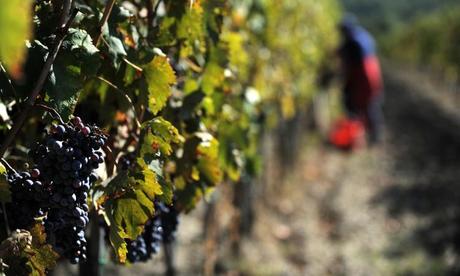Wall-Ye Wine Robot Takes Bow in Burgundy

A new vineyard worker is looking for a job in France. White with red trim, 50 centimetres (20 inches) tall and 60 wide, he has four wheels, two arms and six cameras, prunes 600 vines per day, and never calls in sick.
The Wall-Ye V.I.N. robot, brainchild of Burgundy-based inventor Christophe Millot, is one of the robots being developed around the world aimed at vineyards struggling to find the labour they need.
It takes on labour-intensive chores likes pruning and de-suckering -- removing unproductive young shoots -- while collecting valuable data on the health and vigour of the soil, fruit and vine stocks.
Sales demonstrations are about to begin, and big name French vintners like Bordeaux's First Growth Chateau Mouton-Rothschild have offered their vineyards as a venue for the 20-kilogramme (44-pound) robot to put on its show.
Wall-Ye draws on tracking technology, artificial intelligence and mapping to move from vine to vine, recognise plant features, capture and record data, memorise each vine, synchronise six cameras and guide its arms to wield tools.
An in-built security mechanism is designed to thwart would-be robot snatchers.
"It has a GPS, and if it finds itself in a non-designated vineyard, it won't start. It also has a gyroscope so it knows if it's been lifted off the ground," Millot said.
"If that happens, the hard-drive self-destructs and the robot sends a message to the winegrower: 'Help!'"
Millot's inspiration came from a frustrated winegrower, Denis Fetzmann, estate manager at Domaine Louis Latour, while on a tour of his vineyards in France's southeastern Ardeche region.
"He needed to thin the leaves, because the clusters were too big and they didn't dare use a machine -- but they couldn't find workers. It was August and everyone was on holiday. I told him I'd make him a robot," said Millot.
-- "Novice pruners have to be trained each year" --
To do so took three long years.
"Honestly, it was thousands of hours of work for the two of us -- weekends and nights," said Guy Julien, the toolmaker who partnered Millot to manufacture the robot.
"The biggest challenge was to make the cameras understand what they are seeing and how to interpret it," added Millot.
Demos using a prototype have already sparked a buzz in winemaker circles.
Excited vintners have rung up Millot with a list of tasks they'd like to delegate.
"Every winegrower asks for different things," said the inventor. "In Alsace, for example, they wanted de-suckering with a simple knife to clean up the tops of the Gewurztraminer."
The price tag for the Wall-Ye robot is set at 25,000 euros ($32,000), the same as a medium-size car.
"Which isn't bad considering it works day and night, even Sundays, doesn't take holidays or stop for a snack," Julien said.
"If I have the choice between the robot and the employee, I'll take the robot -- it's less expensive and less trouble," said Patricia Chabrol, owner of Chateau Gerbaud in Saint Emilion who has seen Wall-Ye at work.
"We have robots in factories, robots that take care of the elderly -- I think we can do some very high quality work with this vineyard robot."
And what of concerns the robot could destroy jobs at a time when French unemployment stands at three million?
"Obviously this means we'll cut the job for vineyard pruners, but we're creating jobs for someone who has gone to school and who will build, maintain and improve the robots," was Julien's response.
"And we're going to keep the manufacturing in France."
Wall-Ye is one of a handful of similar projects under development in the wine world. Both California and New Zealand are developing intelligent vision-based pruning robots.
Richard Green of the University of Canterbury is developing a pruning robot backed by French drinks giant Pernod Ricard. He predicts it will save the New Zealand wine industry 17.6 million euros ($23 million) per year through increased productivity and reduced yield losses.
"But it's not just about labour costs, it's about the quality of the pruning. We often have novice pruners who have to be trained each year," Green said.
In California, Vision Robotics founder Bret Wallach said their robotic vine pruner, still in test phase, is three metres (10 feet) tall with eight cameras, and pairs a 3D model of the vines with customised pruning rules.
"It's the same rules you would give a manual crew," said Wallach. But manual crews are growing scarce in California. "And it gets worse every year."
Labour issues aside, some French growers are unwilling to see robotic pruners industrialise what has historically been a craft-based product.
"Technically it's interesting, but intellectually, it's inconceivable. It doesn't fit with my philosophy of making a Saint Emilion grand cru," said Philippe Bardet, owner of Chateau du Val d'Or.
"I'm all for automating certain tasks, but not pruning."
Pruning is a particularly sensitive task because it tells the vine how many bunches of grapes to produce and affects its ability to ripen the fruit to perfection.
"Each plant is unique in terms of things like vigour, so it must be treated uniquely during pruning," said Fetzmann of Domaine Louis Latour.
"But I can see a robot doing the pre-pruning in November, and humans finishing in March. A machine like this could be really useful stocking data about each individual vine stock, adapting treatments to the diversity in vegetation and soil even within a plot."
Many vintners surveyed in a straw poll by AFP considered vineyard robots to be an inevitable development.
"We once said we'd never use machines to harvest, now we do," said Fetzmann. "Everything that can be mechanised will eventually be mechanised."



